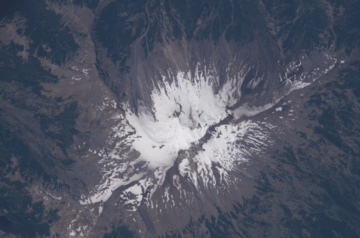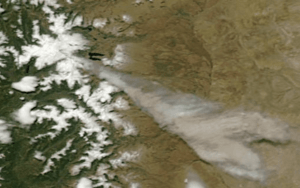Copahue facts for kids
Quick facts for kids Copahue |
|
|---|---|

Copahue Volcano photographed from space
|
|
| Highest point | |
| Elevation | 2,997 m (9,833 ft) |
| Geography | |
| Location | Neuquén Province, |
| Parent range | Andes |
| Geology | |
| Mountain type | Stratovolcano |
| Last eruption | January 6, 2016 |
Copahue (Spanish pronunciation: [koˈpawe]) is a tall, cone-shaped volcano called a stratovolcano. It sits high up in the Andes mountains. This volcano is special because it's right on the border between Chile (in the Bío Bío Region) and Argentina (in Neuquén Province).
Copahue has nine volcanic craters lined up over about 2 kilometers (1.2 miles). The crater furthest to the east is usually the most active. Inside this crater, there's a lake about 300 meters (1,000 feet) wide. This lake is very acidic, with a pH between 0.18 and 0.30. When the volcano erupts, this lake can shoot out hot pieces of rock and even chilled bits of liquid sulfur. In 2000, the lake emptied during an eruption, but it later filled up again. The name Copahue means "sulphur waters" in the Mapuche language.
How Copahue Formed
Copahue sits on top of older rocks that formed a long time ago. These rocks include sedimentary rocks (like sandstone or shale) and other volcanic rocks. They range in age from the Eocene to the Pliocene periods.
Ancient Volcanic Activity
The area around Copahue has been volcanically active for millions of years. To the east of Copahue, there's a very old, large basin called a caldera. This caldera formed during the Pliocene period and measures about 20 kilometers (12 miles) by 15 kilometers (9 miles).
The modern Copahue volcano started to become active around 1.2 million years ago. The current caldera, which is a large crater formed when a volcano collapses, developed between 600,000 and 400,000 years ago. When it formed, it created huge flows of hot gas and rock called pyroclastic flows. These flows traveled very far, up to 37 kilometers (23 miles) from the volcano!
Recent Activity
The main part of Copahue today looks like a long, wide shield volcano. It's thickest at about 22 kilometers (14 miles) and thinnest at 8 kilometers (5 miles).
Eruptions and Alerts
Copahue has erupted ten times since the year 1900. Its most recent eruption was in March 2016.
On May 27, 2013, a "red alert" was issued for the volcano. This meant that an eruption was very likely or already happening. Because of this, about 2,000 people living nearby had to be evacuated from their homes to stay safe.
See also
- List of volcanoes in Chile
- List of volcanoes in Argentina
 In Spanish: Volcán Copahue para niños
In Spanish: Volcán Copahue para niños




